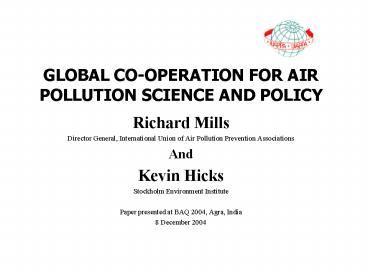GLOBAL COOPERATION FOR AIR POLLUTION SCIENCE AND POLICY - PowerPoint PPT Presentation
1 / 14
Title:
GLOBAL COOPERATION FOR AIR POLLUTION SCIENCE AND POLICY
Description:
GLOBAL CO-OPERATION FOR AIR POLLUTION SCIENCE AND POLICY. Richard Mills ... on pollutant transport characteristics and will be diverse and over-lapping. ... – PowerPoint PPT presentation
Number of Views:29
Avg rating:3.0/5.0
Title: GLOBAL COOPERATION FOR AIR POLLUTION SCIENCE AND POLICY
1
GLOBAL CO-OPERATION FOR AIR POLLUTION SCIENCE AND
POLICY
- Richard Mills
- Director General, International Union of Air
Pollution Prevention Associations - And
- Kevin Hicks
- Stockholm Environment Institute
- Paper presented at BAQ 2004, Agra, India
- 8 December 2004
2
IUAPPA
- Founded in 1964
- To promote progress in the prevention and control
of air pollution - Member organisations in some 40 countries
- Key current issues
- - Long-range transport of air pollution
- - Interaction of climate change and pollution
- - Transport and air quality in major cities
- Triennial World Clean Air Congress etc
3
OVERVIEW
- A few words of history
- What has changed in the last decade
- - Evolving pattern of emissions and impacts
- - Institutional developments
- - New and Emerging Issues
- Possible ways forward
- - Regional networks
- - Hemispheric Co-operation
- - From regional to global
- Work of the Forum
4
Sulphur Emissions in Europe since 1980
5
Meanwhile Emissions in Other Regions are
increasing, rapidly in some cases
6
REGIONAL AND HEMISPHERIC TRANSPORT IN THE USA
7
NEW AND EMERGING ISSUES
- Increased concern in developed and developing
countries Rising emissions in developing world
increase concern there, while falling emissions
in areas of developed world increase the relative
importance of pollution from outside - Increasing evidence of hemispheric transport
satellite and remote observation - Key pollutants Particles and Ozone regional
and hemispheric scales - Reactive nitrogen and disturbance of the global
nitrogen cycle - Interaction of climate change and pollution
8
INSTITUTIONAL RESPONSES
- Treaty-based systems sometimes free standing,
sometimes environmental chapters of wider
agreements CLRTAP, Malé, US/Canada, Mercosur - Non-Treaty based inter-governmental systems
EANET, APINA - Scientific based initiatives e.g. IANABIS, ABC
- All three models can have valuable and mutually
supportive roles. But formal treaty or protocol
base likely to be necessary as reciprocal actions
and differentiated obligations begin to emerge.
9
MAJOR INITIATIVES IN ASIA
- Coverage now extensive and complex
- Malé Declaration, ASEAN Haze Agreement, UNECE
- EANET
- Indoex, ABC, CAI-Asia
10
Malé Declaration on the Control and Prevention of
Air Pollution and its Likely Transboundary
Effects in South Asia
8 SACEP countries have agreed to
cooperate Network developed (annual meetings of
FPs and NIAs) Scientific assessment has started
(monitoring network set up in 2003/2004)
11
EANET Acid Deposition Monitoring Network in EAST
ASIA
- EANET aims to
- Create common understanding about acid deposition
in E Asia - Provide inputs to decision making in the region
- Promote mutual cooperation on issues related to
acid deposition - Monitoring network is current focus
12
UN Economic Commission for Europe
(UN/ECE) Convention on Long-Range Transboundary
Air Pollution (CLRTAP)
49 parties to the Convention 8 Protocols signed
with commitments to reduce emissions of S, N,
VOCs, HMs, POPs Convention structure promotes
efficient flow of science to policy and
vice-versa emissions officially reported using
EMEP/CORINAIR manual, EMEP transfer model
officially recognised, IIASA-Rains model used to
develop strategies
13
MODELS FOR GLOBAL CO-OPERATION
- Co-operative Framework for Regional Networks
- Hemispheric Co-ordination Ozone
- From regional to global regulation POPs
- Relevant interventions will depend on pollutant
transport characteristics and will be diverse and
over-lapping. - To address the inevitably complex systems that
result a more coherent global framework will
become increasingly important.
14
TASKS FOR AN INTER-REGIONAL FORUM
- Explore common problems and share experience
- Develop more consistent and compatible systems
and approaches - Provide a co-operative framework within which air
pollution policies and measures at the
hemispheric and global scales can be explored and
integrated - Contribute to more balanced debate of the issues
surrounding the relationship between air
pollution and climate change - Help raise the public profile and understanding
of regional and hemispheric air pollution issues.































